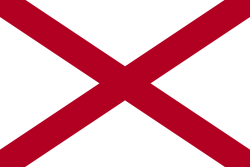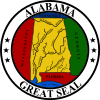Alabama | |
|---|---|
| Nicknames: the Yellowhammer State, the Heart of Dixie, the Cotton State | |
| Motto(s): | |
| Anthem: "Alabama" | |
 Map of the United States with Alabama highlighted | |
| Country | United States |
| Before statehood | Alabama Territory |
| Admitted to the Union | December 14, 1819 (22nd) |
| Capital | Montgomery |
| Largest city | Huntsville |
| Largest county or equivalent | Jefferson |
| Largest metro and urban areas | Greater Birmingham |
| Government | |
| • Governor | Kay Ivey (R) |
| • Lieutenant governor | Will Ainsworth (R) |
| Legislature | Alabama Legislature |
| • Upper house | Senate |
| • Lower house | House of Representatives |
| Judiciary | Supreme Court of Alabama |
| U.S. senators | Tommy Tuberville (R) Katie Britt (R) |
| U.S. House delegation | 6 Republicans 1 Democrat (list) |
| Area | |
| • Total | 52,419 sq mi (135,765 km2) |
| • Land | 50,744 sq mi (131,426 km2) |
| • Water | 1,675 sq mi (4,338 km2) 3.2% |
| • Rank | 30th |
| Dimensions | |
| • Length | 330 mi (531 km) |
| • Width | 190 mi (305 km) |
| Elevation | 500 ft (150 m) |
| Highest elevation | 2,413 ft (735.5 m) |
| Lowest elevation | 0 ft (0 m) |
| Population (2020) | |
| • Total | 5,024,279[3] |
| • Rank | 24th |
| • Density | 99.2/sq mi (38.3/km2) |
| • Rank | 27th |
| • Median household income | $52,000[4] |
| • Income rank | 46th[5] |
| Demonym(s) | Alabamian,[6] Alabaman[7] |
| Language | |
| • Official language | English |
| • Spoken language | As of 2010[update][8]
|
| Time zones | |
| Entire state (legally) | UTC– 06:00 (Central) |
| • Summer (DST) | UTC– 05:00 (CDT) |
| Phenix City area (unofficially) | UTC– 05:00 (Eastern) |
| • Summer (DST) | UTC– 04:00 (EDT) |
| USPS abbreviation | AL |
| ISO 3166 code | US-AL |
| Traditional abbreviation | Ala. |
| Latitude | 30°11' N to 35° N |
| Longitude | 84°53' W to 88°28' W |
| Website | alabama |
| List of state symbols | |
|---|---|
 | |
 | |
 | |
| Slogan | Share The Wonder, Alabama the beautiful, Where America finds its voice, Sweet Home Alabama |
| Living insignia | |
| Amphibian | Red Hills salamander |
| Bird | Yellowhammer, wild turkey |
| Butterfly | Eastern tiger swallowtail |
| Fish | Largemouth bass, fighting tarpon |
| Flower | Camellia, oak-leaf hydrangea |
| Horse breed | Racking horse |
| Insect | Monarch butterfly |
| Mammal | American black bear |
| Reptile | Alabama red-bellied turtle |
| Tree | Longleaf pine |
| Inanimate insignia | |
| Beverage | Conecuh Ridge Whiskey |
| Color(s) | Red, white |
| Dance | Square dance |
| Food | Pecan, blackberry, peach |
| Fossil | Basilosaurus |
| Gemstone | Star blue quartz |
| Mineral | Hematite |
| Rock | Marble |
| Shell | Johnstone's junonia |
| Soil | Bama |
| State route marker | |
 | |
| State quarter | |
 Released in 2003 | |
| Lists of United States state symbols | |
Alabama (/ˌæləˈbæmə/ AL-ə-BAM-ə)[9] is a state in the Southeastern region of the United States. It borders Tennessee to the north, Georgia to the east, Florida and the Gulf of Mexico to the south, and Mississippi to the west. Alabama is the 30th largest by area[10] and the 24th-most populous of the 50 U.S. states.[11]
Alabama is nicknamed the Yellowhammer State, after the state bird. Alabama is also known as the "Heart of Dixie" and the "Cotton State". The state has diverse geography, with the north dominated by the mountainous Tennessee Valley and the south by Mobile Bay, a historically significant port. Alabama's capital is Montgomery, and its largest city by population and area is Huntsville.[12] Its oldest city is Mobile, founded by French colonists (Alabama Creoles) in 1702 as the capital of French Louisiana.[13][14] Greater Birmingham is Alabama's largest metropolitan area and its economic center.[15] Politically, as part of the Deep South, or "Bible Belt", Alabama is a predominantly conservative state, and is known for its Southern culture. Within Alabama, American football, particularly at the college level, plays a major part of the state's culture.
Originally home to many native tribes, present-day Alabama was a Spanish territory beginning in the sixteenth century until the French acquired it in the early eighteenth century. The British won the territory in 1763 until losing it in the American Revolutionary War. Spain held Mobile as part of Spanish West Florida until 1813. In December 1819, Alabama was recognized as a state. During the antebellum period, Alabama was a major producer of cotton, and widely used African American slave labor. In 1861, the state seceded from the United States to become part of the Confederate States of America, with Montgomery acting as its first capital, and rejoined the Union in 1868. Following the American Civil War, Alabama would suffer decades of economic hardship, in part due to agriculture and a few cash crops being the main driver of the state's economy. Similar to other former slave states, Alabamian legislators employed Jim Crow laws from the late 19th century up until the 1960s. High-profile events such as the Selma to Montgomery marches made the state a major focal point of the civil rights movement in the 1950s and 1960s.
During and after World War II, Alabama grew as the state's economy diversified with new industries. In 1960, the establishment of NASA's Marshall Space Flight Center in Huntsville helped boost Alabama's economic growth by developing a local aerospace industry. Alabama's economy in the 21st century is based on automotive, finance, tourism, manufacturing, aerospace, mineral extraction, healthcare, education, retail, and technology.[16]
- ^ "Cheehahaw". NGS Data Sheet. National Geodetic Survey, National Oceanic and Atmospheric Administration, United States Department of Commerce. Retrieved October 20, 2011.
- ^ a b "Elevations and Distances in the United States". United States Geological Survey. 2001. Archived from the original on October 15, 2011. Retrieved October 21, 2011.
- ^ "2020 Census Apportionment Results" (PDF). The United States Census Bureau. April 26, 2021. Archived (PDF) from the original on April 26, 2021. Retrieved April 27, 2021.
- ^ "US Census Bureau QuickFacts". Archived from the original on March 13, 2022. Retrieved April 30, 2022.
- ^ "Median Household Income by State 2022". Archived from the original on September 7, 2022. Retrieved August 4, 2022.
- ^ "State of Alabama". The Battle of Gettysburg. Archived from the original on July 13, 2014. Retrieved July 21, 2014.
- ^ "Oxford English Dictionary". www-oed-com. Oxford University Press. Retrieved September 30, 2020.
- ^ Stephens, Challen (October 19, 2015). "A look at the languages spoken in Alabama and the drop in the Spanish speaking population". AL.com. Archived from the original on October 9, 2016. Retrieved September 21, 2016.
- ^ "Alabama". CollinsDictionary.com. HarperCollins. Retrieved March 8, 2024.
- ^ "Ranking of U.S. States by Area". Archived from the original on December 17, 2022. Retrieved November 7, 2022.
- ^ "US States – Ranked by Population 2022". Archived from the original on March 24, 2022. Retrieved November 7, 2022.
- ^ "Huntsville rockets past Birmingham in Census, now Alabama's largest city". al. August 12, 2021. Archived from the original on August 12, 2021. Retrieved August 12, 2021.
- ^ Thomason, Michael (2001). Mobile: The New History of Alabama's First City. Tuscaloosa: University of Alabama Press. pp. 2–21. ISBN 978-0-8173-1065-3.
- ^ Melton McLaurin, Michael Thomason (1981). Mobile the life and times of a great Southern city (1st ed.). United States of America: Windsor Publications. pp. 12, 15, 16, 17, 18, 19, 20, 21, 24, 33, 34, 35, 36, 37, 38, 39, 41. 42, 43, 44, 45, 46, 49, 50, 51, 52, 53, 54, 55, 88, 92, 105, 119, 120, 123.
- ^ "Alabama's largest county looks to continue economic development momentum". August 31, 2018. Archived from the original on October 21, 2020. Retrieved September 21, 2020.
- ^ "Alabama Occupational Projections 2008–2018" (PDF). Alabama Department of Industrial Relations. State of Alabama. Archived from the original (PDF) on January 17, 2013. Retrieved September 22, 2012.
Cite error: There are <ref group=lower-alpha> tags or {{efn}} templates on this page, but the references will not show without a {{reflist|group=lower-alpha}} template or {{notelist}} template (see the help page).


